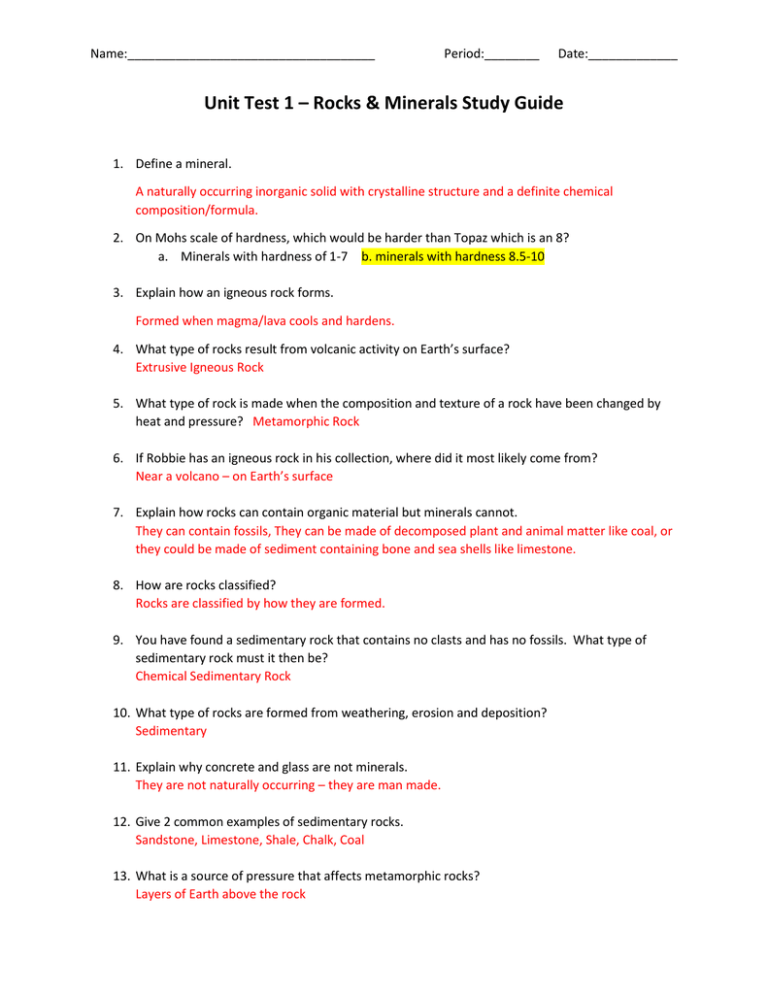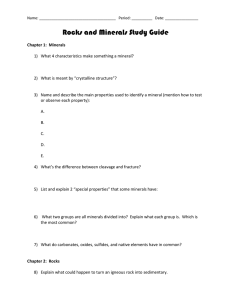Unit Test 1 – Rocks & Minerals Study Guide
advertisement

Name:____________________________________ Period:________ Date:_____________ Unit Test 1 – Rocks & Minerals Study Guide 1. Define a mineral. A naturally occurring inorganic solid with crystalline structure and a definite chemical composition/formula. 2. On Mohs scale of hardness, which would be harder than Topaz which is an 8? a. Minerals with hardness of 1-7 b. minerals with hardness 8.5-10 3. Explain how an igneous rock forms. Formed when magma/lava cools and hardens. 4. What type of rocks result from volcanic activity on Earth’s surface? Extrusive Igneous Rock 5. What type of rock is made when the composition and texture of a rock have been changed by heat and pressure? Metamorphic Rock 6. If Robbie has an igneous rock in his collection, where did it most likely come from? Near a volcano – on Earth’s surface 7. Explain how rocks can contain organic material but minerals cannot. They can contain fossils, They can be made of decomposed plant and animal matter like coal, or they could be made of sediment containing bone and sea shells like limestone. 8. How are rocks classified? Rocks are classified by how they are formed. 9. You have found a sedimentary rock that contains no clasts and has no fossils. What type of sedimentary rock must it then be? Chemical Sedimentary Rock 10. What type of rocks are formed from weathering, erosion and deposition? Sedimentary 11. Explain why concrete and glass are not minerals. They are not naturally occurring – they are man made. 12. Give 2 common examples of sedimentary rocks. Sandstone, Limestone, Shale, Chalk, Coal 13. What is a source of pressure that affects metamorphic rocks? Layers of Earth above the rock Name:____________________________________ Period:________ Date:_____________ 14. Maria found a rock with a fossil in it. What type of rock must it be? Sedimentary 15. When limestone is exposed to heat and pressure it changes into another type of rock. What type of rock must this be? Metamorphic rock 16. Why do extrusive igneous rocks have small grains? They cool down FAST 17. If you study a diagram of sedimentary rock layers, which layer will have the oldest fossils? The lower layer 18. How does a sedimentary rock become a metamorphic rock? Is goes through heat and pressure 19. How does a metamorphic rock become an igneous rock? Melts into magma, then cools 20. What type of rock is formed when weathering and erosion take place on a hillside by the sea? Sedimentary 21. What formation process is required to change a sedimentary rock into an igneous rock? MELTING 22. Why do Obsidian and Pumice have no crystals? Because they cooled quickly – they are igneous rocks 23. Substances that cannot be broken down into simpler substances or separated by any means are called what? Elements 24. Name the two major groups of MINERALS. Silicate & Non-Silicate 25. How do metamorphic rocks become igneous rocks? Heat & Pressure






